#maori hongi
Text
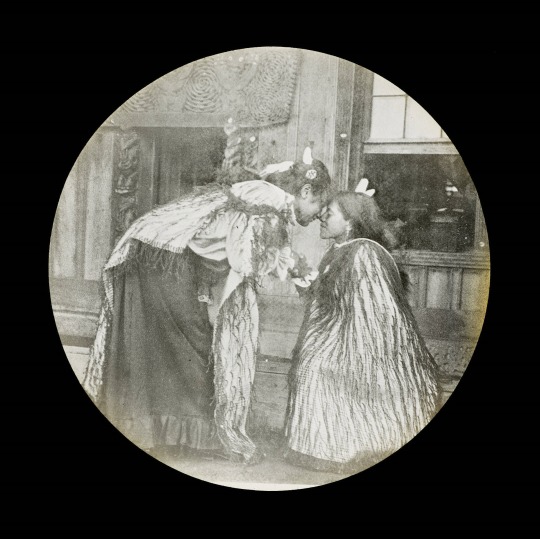
Unidentified Māori women greeting each other with a hongi alongside the entrance to an unidentified meeting house. Image taken for the New Zealand Tourist and Publicity Department, 1900-1909
102 notes
·
View notes
Text

Don't forget your promise to come back soon, Echo.
#the bad batch#tbb echo#tbb omega#she loves her big brother so much#it's just goodbye for a little while Omega#I promise#i'm letting his hair grow in a little#just a little theraputic artwork until the new season airs#i love them a normal amount#nose touching = maori hongi = keldabe kiss
11 notes
·
View notes
Text
Hey after the fight, when Jim helps Archie up and they press foreheads/noses briefly together, do you think that was the Hongi?
3 notes
·
View notes
Text
the hongi is such a nice greeting. i wish i did it more in my life. i guess i feel like i had no reason to do it unless i was welcomed at a marae, or if someone wanted to do it
but i should do it anyway because, fuck it, i live in Aotearoa NZ and I should embrace the culture and appreciate it more. I was /born/ here so ofc I should do that
#in recent months I went to two marae and it was such a cool experience#if you were born in Aotearoa NZ you should visit a marae if you EVER get the chance#it really makes you appreciate the culture more#like hell id learn Maori if I had the time tbh#and energy#maybe it's a good thing I took Japanese in high school#they have similar sounds#and i have an idea of what it's like to learn a language too#i heard japanese and Maori have similar sentence structures too#so that may help lol#however ive forgotten a lot of japanese over the years after leaving h igh school sadly#hell ANYONE should go and visit a marae if you ever visit Aotearoa nz#it's just. A really cool experience.#anyway that second time i went to a marae. that wasn't a school marae. we did the hongi#and honestly ive always wanted to do one#it's just such a nice way to greet people#esp when it's with people you've spent quite a bit of time with and have a bond with yknow
3 notes
·
View notes
Note
omg a māori f1 writer! not a request, but genuine question - who’s someone you can see being with a māori girl 👀 like who can you see being taken to a marae and learning how to hongi and meeting all the aunties and uncles
Haha omg it would be such an eye opener for all of them!
Lewis: he would be the type to ask to come with you because he wants to know more about where you come from. He is eager to learn and inquisitive, feeling prepared when he arrives at your ancestral land to a pōwhiri. Lewis has tears in his eyes when he sees the beautiful brown woman welcoming him with a karanga and from there he falls in love with the culture. He loves that there are always dozens of kids hanging around the marae and he never has a chance to sit down as he plays games with them for hours - they also teach him the haka. He would particularly like those hours after dinner where someone brings out their guitar and everyone sings along, the aunties harmonising perfectly, and he feels connected even if he doesn't understand the words.
Daniel: for obvious reasons 😂 being an Aussie, he’s laid back and it probably wouldn’t be the first time drinking a crate of beers in a paddock in the middle of nowhere. It would feel like a second home to him once he remembers to take his shoes off before he steps inside the marae. He doesn’t mind kissing every aunty on the cheeks but takes a bit of practice going in for a hongi without missing the uncles nose. After the formalities are done he is in his element and charms everyone which his infectious smile and constantly makes them laugh.
Oscar: another Aussie that is chilled af so he wouldn’t cause any drama at the marae. He is polite and helpful so the aunties love him and try to coax him out of his quiet state while recalling stories of you as they peel hundreds of potatoes. He is strong too so the uncles would steal him to dig the hangi pit and take the moment to threaten him if he hurts you. He can't hide his surprise when you explain the sleeping arrangements but after all the mattresses are laid out in one cavernous room he warms up to the idea and even feels nostalgic for the nights his family/cousins/friends would all sleep over and they would all drag their mattresses to the living room.
Lando: he’s lived/raced in NZ when he was younger so there would be a sense of familiarity coming back. He likes learning about different cultures (like his recent trip to the temples in Bali) so he would pay attention to the rundown given about customs. Unfortunately he has a terrible memory and may make a few mistakes with what’s tapu like snacking in the marae or sitting on the table. Also, he would fall in love with the food because there’s nothing spicy, something he cannot handle. Known to giggle at inappropriate times with the little cuzzies like when someone says whakapapa. Wakes up to find he rolled the wrong way in the night and is spooning an uncle not you.
Max: takes everything too seriously and is worried about messing up so he buys a book on Maori culture as soon as he lands at Auckland Airport and finishes by the time he reaches the marae. Is pleasantly surprised to find that after the formalities the entire atmosphere relaxes and he is treated like he has always been there. The aunties shoo him out of the kitchen when he tries to help, handing him a drink and sending him to the uncles who are all inspecting the new 4x4 someone bought. Surprisingly, he learns a bit about cars from them and wants his own Ford Ranger or Toyota Hilux now, despite Daniel trying to get him to convert to one for years.
106 notes
·
View notes
Text




In the hongi, the ha (breath of life) is exchanged in a symbolic show of unity. Between the cultures of Samoan, Maori, and Hawaiian we may find some differences but they do share a common cultural heritage.
110 notes
·
View notes
Photo


Taika Waititi doing "Hongi” to Maori presenter at Thor: Love & Thunder Premiere in Sydney
source: Marae TVNZ
731 notes
·
View notes
Text
I have decided that the Lalondes are Maori and furthermore I am more correct about this than anyone has ever been.
My evidence:
Rose
Engaged in a battle with her mother of who can say the most eloquent (and longest) karakia because she always hated saying them so now tries to continuously one up her mother by being slightly more precise with hers. Dinner is always an hour late because of this.
Despises the insistence of motherhood in Maori folklore (especially ones her mother teaches her) and finds them to be incredibly stifling.
She hates doing kapa haka and hates that women cannot do a full haka, so she puts on a one woman performance herself when she is young during a “ridiculous” matariki celebration her mother was putting on, and did a male haka by herself. Mom found this extremely adorable and insists on playing the video every Matariki, which Rose hates.
Her favorite nursery rhyme growing up was “One Day a Taniwha”
Rose loves taniwha, though she acts like she doesn’t.
On the meteor she wishes she had actually learned about her culture with her mother when she had the chance instead of only engaging with it ironically and feels very separate from the others on the meteor because of it.
After she is on the meteor towards the end of homestuck I think she reconciles her heritage with her lack of motherliness in the idea of women less as mothers but as powerful dangerous people (a la the goddess of death, Hine-nui-te-pō, who kills Maui with her thighs)
She is so annoyed with the lack of taking care of the land when they reach Earth C. She did not really consider Papatuanuku as her mother before but she realizes now after seeing how all the other kids and especially some of the trolls behave, acting like the land is something to be used and discarded she gets extremely annoyed. She, Roxy, and Jade bond over this.
Her mother gave her a Koru pounamu to celebrate her becoming a woman on her first period. She resentented it and refused to wear it, but eventually accepted it and passed it down to Roxy who was overjoyed to receive it.
She instead wears a Hei Tiki pounamu necklace Dave gave to her as a wedding present. She acts aloof about it but anyone who knows her can tell she is deeply moved by the gift. She keeps it on at all times.
Roxy
There is an inherent horror to looking all around you to see that Tangaroa has drowned his mother.
The idea that The Condesce, a colonizer, took over the world and left Roxy stranded on a tiny piece of land with almost none of her people or culture left, and she can never sail out on a waka like her ancestors or a sailboat like the ancestors of her ancestors to see other places, trapped in a tiny select space. It’s a horror I can’t really describe.
Roxy desperately wants to know what tribe she comes from and who she descends from, to find that little bit of her family. She is very quiet on the day she finds out she was produced from herself.
Roxy misses Papatuanuku, she misses her chance to meet both her mothers before they died. She messages Dirk about this while drunk but he does not fully get it.
As a trans woman, finds the women in Maori mythology and culture to be aspirational figures of power and motherhood.
She thanks the appropriate gods for any food she can scavenge for in her apocalypse but never really has the time to learn a full karakia.
Teaches the carapacians kapa haka, they aren’t very good at it but they do make up for it with enthusiasm
When she enters the session she insists on hongi (sharing breath) with each of her friends. It goes like this:
Dirk: Has been preparing for this for years. Has the whole technique down. Confident cool guy swagger, but not too much, he doesn’t look like he’s trying too hard either. He and Roxy bump their heads together and fall over. This looks ridiculous.
Jake: Roxy explains and leans in to do a hongi with him but he kisses her on both cheeks like he is french. Roxy thinks this is hilarious.
Jane: Needs at least 6 tries to get it right but keeps on insisting on doing it again so she can participate in Roxy’s culture appropriately, and then a couple more times because she keeps failing on purpose to make Roxy laugh. They are both in a fit of giggles by the time she has worked it out and it becomes their standard greeting.
Hal: Is a computer, but Roxy does hold the nose bridge of the glasses up to her face like they are doing a hongi which Hal does appreciate.
Calliope: Gets it right first try!
Goes somewhat crazy hanging out in nature on Earth C. (Where is Roxy? In The Mud. Of course.)
I cannot express in words as well, the sheer euphoria Roxy feels standing on the ground on Earth C.
#jade and jake are also Pacifica. to me.#source: dude trust me#homestuck#rose lalonde#roxy lalonde#mom lalonde#I mostly was thinking this headcanon as a joke because all the maori rep in this fandom sucks ass but tbh I am just correct I think
13 notes
·
View notes
Text

Princess Anne performing a Hongi (Maori greeting) during a visit to Tasmania in 1989.
#I WANT TO BE THAT WOMAN#HER NOSE#PLEASE#SO CUTE#🥰🥰🥰#princess anne#princess royal#brf#british royal family#my gifs
80 notes
·
View notes
Text
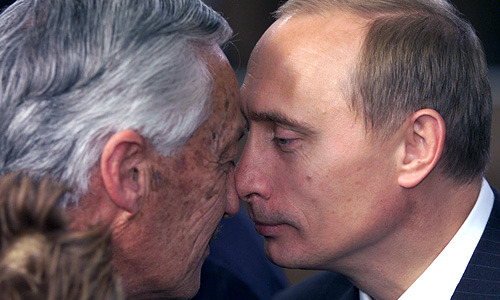
"Hongi" is a traditional Maori greeting. During a meeting of OPEC leaders. September 12, 1999.
I personally wouldn't do this to anyone I have just met.
#vladimir vladimirovich putin#vladdy daddy#Russian Prime Minister Vladimir Putin#Премьер-министр России Владимир Путин
2 notes
·
View notes
Note
🥺 feels pls (for the ask game)
🥺- Is there a certain type of moment or common interaction between your characters that never fails to put you in your feels?
Well there is the whole uhh last Thelem scene in Exile//Vilify thing and since I wrote that scene really early on, any of the interactions between Thelem and Astor just make me go 🥺
In my pokemon fics, Archie and Maxie press foreheads together. It's loosely inspired by the Maori hongi which I think is really neat and it always makes me go 🥺 as well
Writing tag game!! - ask me writer things
#ask game#tag game#asks#writing game#as i slowly get back into editing and writing as my life calms down
3 notes
·
View notes
Text
Fathoms Below notes!
Kia ora!
First of all, let me say that, in the terms I learned from my English class this year when we read a story by a Māori writer, I am Pākehā,meaning 'different' as opposed to Māori, meaning 'same'. It's a general term for anyone who is not Māori. By no means am I an expert in Pacific Islander culture. I've just googled shit so it seems like I know something. All of my information is either from Google (search and Translate), a little bit from youtube, and a lot of the Moana Jr. script I used for dialogue reference.
Let's start with my usage of words in not-English. Most of them are in te reo Māori (the maori language), also known as te reo (the language). Kia ora (te reo) is one such example, and it's just a simple greeting. Whakatara (te reo) = a swear word that probably shouldn't be in a Disney movie. Atua (te reo) = god(s). Maero = a traditional Māori violent giant. Pulotu = Samoan/Tuvaluan place for spirits. Hongi = a traditional Māori greeting in which foreheads are pressed together in a demonstration of pure compassion. Tumatārau (te reo) = magic. Iramutu (te reo) = nephew.
Unfortunately, I don't have the patience or resources to translate all of the songs, but one of the songwriters has a website with all of the translations for you. (opetaiafoai.com)
I did have to change some words because of ugh gender in some of the songs, so to help it blend in, on the Moana side at least, I changed a little bit to Te Reo Māori. I've been listening to that version of the soundtrack for weeks on end now and it's very stuck in my head. So you get to enjoy it with me.
These are tamaiti = child. anei = here. Hua-nati = coconut. Tama = son. Te kāinga = home. How far i'll go has a lot changed so i'll let you google translate that yourself. Mihi mai rā = congratulate me (source: youtube comments. I'll find it again if anyone needs it). Taku tina = my lunch. Tēnā = please. Uia, ko wai koe = ask, who you are. Ko wai au = who am I. (Au) E hao nei = this was pretty difficult for me to find, but hao is like capture, and nei implies nearness. E is just there for grammatical purposes and au is kind of just like 'oh' i think. Taku ara = my way. Ko au a (fitzroy) = i am (fitzroy)
Also, If the songs are in quotes, then a character is singing it. All of the songs are in italics, and really short lines, which make it easier to see. Any end quotes either signal the singing has stopped or a different character is singing. Quoted songs are semi-diegetic, which means it sort of takes place within the story, but it doesn't totally, as--at least as far as I know--people don't just randomly break into song. If there are no quotes, then it is entirely non-diegetic, or background music. Note: kiss the boy cannot be physically heard by Fitz during its runtime, because crabs...can't talk...to humans...idk that's what little mermaid canon calls for, which is why it is not in quotes, but it is diegetic to Dex.
Keefe's full neopronoun set is o ia/ia/lona/lona/ia lava. This is because languages that evolved from proto-polynesian, arguably the native language of all our islander characters, really only use one pronoun that covers everybody. I am using the Samoan pronouns for this, as opposed to Te Reo Māori because I used that quite heavily for Motunui, and it gives some contrast. Te reo, Samoan, and Hawai'ian were also my only options on google translate for this kind of thing.
While I'm talking about Keefe, O ia was born in Fiji (or elsewhere in Melanesia it doesn't matter all that much) and then the gods that saved ia were Samoan, so that explains the blond hair thing. Also, on the island of Samoa, there are traditionally four recognized genders: male, female, fa'afafine, and fa'afatama. There are similar gender roles on other nearby polynesian islands with slightly different names. Fa'a- means 'in the manner of', 'fafine' means 'woman', and 'fatama' means 'man'. This doesn't quite have an exact translation into today's western terminology for gender. It's not quite trans, and it's not quite nonbinary either. In this story, Keefe is fa'afafine for reasons that mostly consist of 'why not?'
We all know Flounder from the Little Mermaid, right? So I did not utilize him very well in this, being recast as Sophie, but I did find out that blue angelfish (which is apparently the type of fish Sophie is) is a protogynous hermaphrodite. What does that mean? A female can change into a male at a certain point in their life. Trans fish, everybody! Also Sophie is probably super lost because he's supposed to live in the Caribbean, but let's just add that to our suspension of disbelief, okay?
Why does Fitz know Dex's pronouns right away, even before he knows xor name? Because it's my fic and I can do what I want. And what I don't want is Fitz to misgender Dex. Also I couldn't function with the thought of she/her Biana so ae had to be ae/aer and by that point i didn't care anymore so xe/xem dex.
While I'm thinking about Dex, I would like to explain my reasoning of why I chose xor native language to be Italian in the spotify playlist. (Side note: while Te Reo Tahiti and 'Ōlelo Hawai'i dubs of moana were made, they are not on spotify, so I was left with Te Reo Māori for Fitz's native language). There is some debate over where it takes place, but one source I saw said that Hans Christian Andersen was inspired by his travels in Italy. Also, look at Prince Eric's castle. At least to me, it feels /super/ Mediterranean. The Little Mermaid does utilize the Greek Gods (namely Poseidon) in its canonical script. That being said, the Greek dub was not on Spotify. Trust me, I tried. We're left with Italian, and it would make sense that if Ariel were to speak a human language as her native tongue, it could very well be the one Eric's kingdom uses. No, there is no Mermish version of The Little Mermaid I could use.
#First chapter released tomorrow at 10 am eastern#12 hours from now if you're bad with time zones or are outside the us#*by now i mean when this is posted#this'll get updated if/when i realize i forgot something#which lets face it is more likely than not#fathoms below
4 notes
·
View notes
Text
Today might be a good day to post this WIP. I need to get my surface fixed so I can color it.
I absolutely love the Polynesian greeting where they press their forehead/nose together (the Maori call it "hongi"). Anyway, I wanted to do one of Omega and Echo giving each other a "welcome home" greeting, because I figured Echo was going to leave for a while with Rex this season.
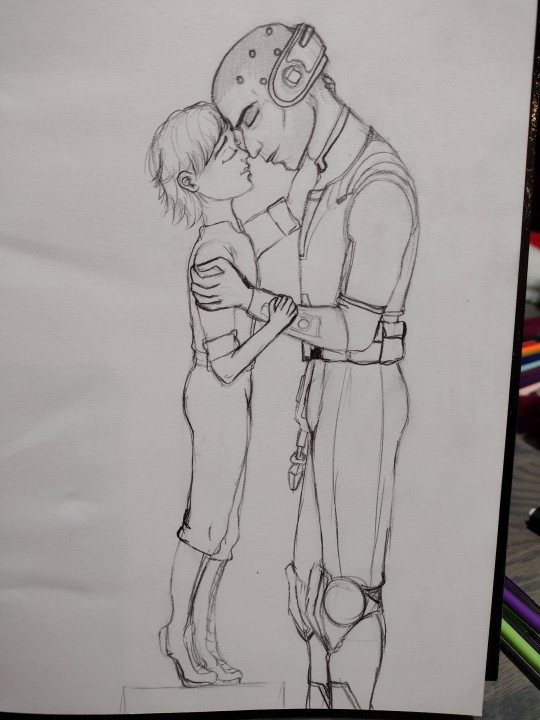
9 notes
·
View notes
Text
Can I take a photo of the Marae?
What is meant by the term ‘the gaze’ in this context?
From my understanding, 'the gaze' is how the audience reacts to a photo and how we build our reputation plus ideas about those captured in a photo. Typically, Maori were subjects in photos in the 19th and 20th centuries but had little control on how they were perceived by Pakeha.
2. Discuss the role of portrait photography in a Maori context. What role does the portrait play?
Portrait photography was a big part of showing the Maori identity. Maori would acknowledge and allow for their deceased ancestors to live on for future generations to see by hanging their portrait in the meeting house.
3. Provide an example (outside of the text) of how portrait photography of Māori was used in the nineteenth century
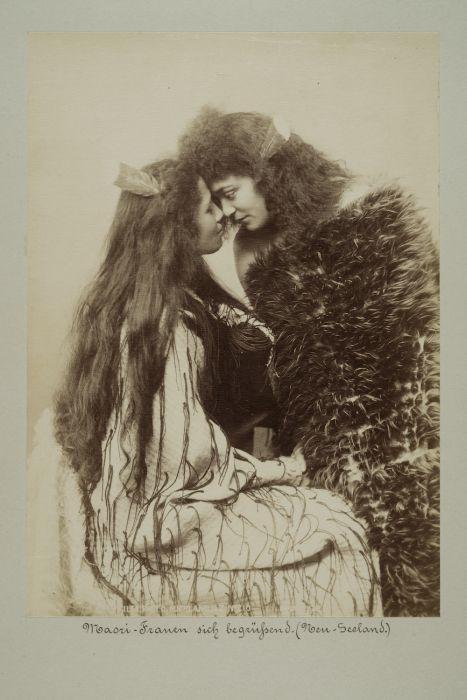
Gottfried Lindauer was a photographer and artist during the 19th century. At the time, there was a high demand for Maori photographs that romanticised Maori ideology, such as the greeting hongi. Often he did not even meet the individuals, which shows his lack of respecting tapu and noa.
View of 0196 The Romanticized Māori – Māori Portraits on Late 19th- and Early 20th-Century Postcards and Photographs | RIHA Journal. (2018). Uni-Heidelberg.de. https://journals.ub.uni-heidelberg.de/index.php/rihajournal/article/view/70271/69999
4. What importance does a marae have to Māori people? Discuss why photographs of a marae might be restricted
A marae is an ancient sacred place where Maori governance is practiced. It holds physical, spiritual and conceptual thresholds where Maori can debate, hold places of peace and gather as a community. Taking photographs is determined by the leaders of the tribe and can change depending on interpretations of tikanga (right ways of doing things). Photographs may interfere with the comfort, safety and protection of the marae and community.
5. What is meant by ‘a loaded and contestable set of issues connected to the act of photographing in and around marae’?
Photography of a marae is contestable as it is a negotiable space, it is up to the leaders of each tribe and community to decide their stance on photography, which could cause issues as tribes may disagree with their position and acceptance of photographing a marae.
6. What is meant by mauri? Discuss how a photography can carry mauri
Mauri means life force and relates to the comfort and protection of the marae and its community. Photography can carry mauri as it can represent the importance of the marae as a sacred site and the tribe that care for the land.
7. What is mana and why is it an important concept?
Mana is the spiritual and force in a person or place that is linked with tapu, which includes sacredness and protection. It is an important concept because it encapsulated important events, people and objects that are associated with Maori identity and history.
8. What are the different kinds of threshold spaces? How might a photographer transgress these spaces?
There is the roadway gate, the carved waharoa (gateway), the marae which is segmented into different regions for visitors, places of debate and places of peace. A photographer needs to be aware that once they pass the marae gates, they have left the outside world and now need to engage and shift to Te Ao Maori.
9. What are the concepts of tapu and noa? How are they relevant to photography in this context?
Tapu represents sacred and noa refers to commonplace. In photography, it is essential that we do not picture something sacred in a bad light, such as a carving, as the living are representing those that have come before us.
10. Why do issues of representation matter in the context of Te Ao Māori?
It is important to represent and acknowledge the people among Maori the community in a Marae as in the past, photographers have quickly gone in and shot what they needed while excluding those occupying their scared place. We need to engage with Maori cultural perspectives and practices.
11. Who are the Pakeha photographers who developed relationships with Te Ao Maori and why is their work important?
Gil Hanly, Fiona Clark, Terry O'Connor, Sally Symes and Jill Carlyle are pakeha photographers who developed relationships with Te Ao Maori. Their work is important because at the time, there were very few Maori photographers and their work helped with being a historical record of the political Maori land occupations (1970-1990).
12. Who is the Maori documentary photographer who won the Media Peace Prize? Look up and provide an example of his work, outside of this text
John Miller, a Maori documentary photographer was awarded the Media Peace Price in 2003.
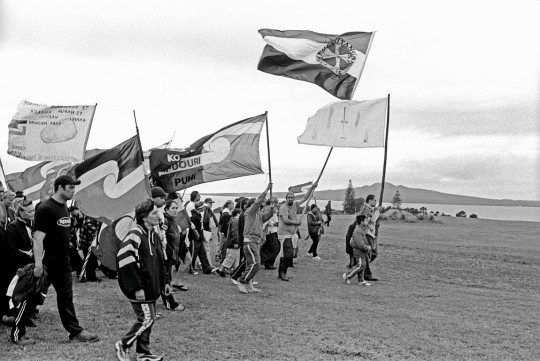
He photographed protests and important events as a witness to what was unfolding in front of him. He honours those who have led the charge for change in our community and society.
Texture of the Time. (2023). Christchurchartgallery.org.nz. https://christchurchartgallery.org.nz/bulletin/205/texture-of-the-time
13. What does Barry Barclay mean by taonga?
Barry Barclay was a twentieth century filmmaker who told Maori stories from a Maori perspective. Taonga referred to the treasures of the Maori community and he felt that their media was owned and property of someone else (copyright and intellectual rights) when it was sacred.
14. What does the Mana Tuturu principle mean and how can it be applied to photography today?
Mana Tuturu is a principle that ensures that Maori have guardianship and and spiritual ownership of legal documents and film that contain a Maori perspective. This can be used in photography today to build a deeper connection with the appointed guardians as well as keeping the copyright owners satisfied.
15. Unpack and answer the questions Can I take a photo of the marae using the AUT Marae Nga Wai o Horotiu as the example?
The AUT Marae Nga Wai o Horotiu is a "whānau, cultural and spiritual centre. It embraces the history of Māori and welcomes the diverse cultures at AUT." I personally feel that I would need a connection with the community that is gathering at the marae to feel as if I am representing their culture and practices in a positive way. With this extra knowledge and research, I know that I would be respectful and understand representing the sacred in a proper way.
16. What does the term ‘kanohi ki kanohi’ mean and why is it important?
'Kanohi ki kanoh' means face-to-face communication and is important to Maori communities. It refers to treating people with respect rather than a transaction. As a photographer, returning to share our photos and experiences can continue this communication.
0 notes
Text
Hongi:
El saludo tradicional Maori que consiste en juntar la nariz y la frente, simbolizando la conexión entre almas.
0 notes
Text
Reading
The AUT'S link "The Pōwhir" describes the protocol and customs of the pōwhiri, a traditional Maori welcoming ceremony at Ngā Wai ō Horotiu Marae. It highlights the significance of the marae ātea as a sacred space and the importance of the karanga, a spiritual call of welcome. The manuhiri pay respects to the deceased before entering the meeting house, where speeches and songs are performed. The hongi, a traditional greeting involving the touching of noses, symbolizes the removal of tapu (sacredness) and the establishment of a connection between the visitors and the hosts. The pōwhiri concludes with the sharing of food, and the manuhiri are welcomed as tangata whenua for the duration of their stay.
This gives me information on what to know when taking pictures in Marae.
0 notes